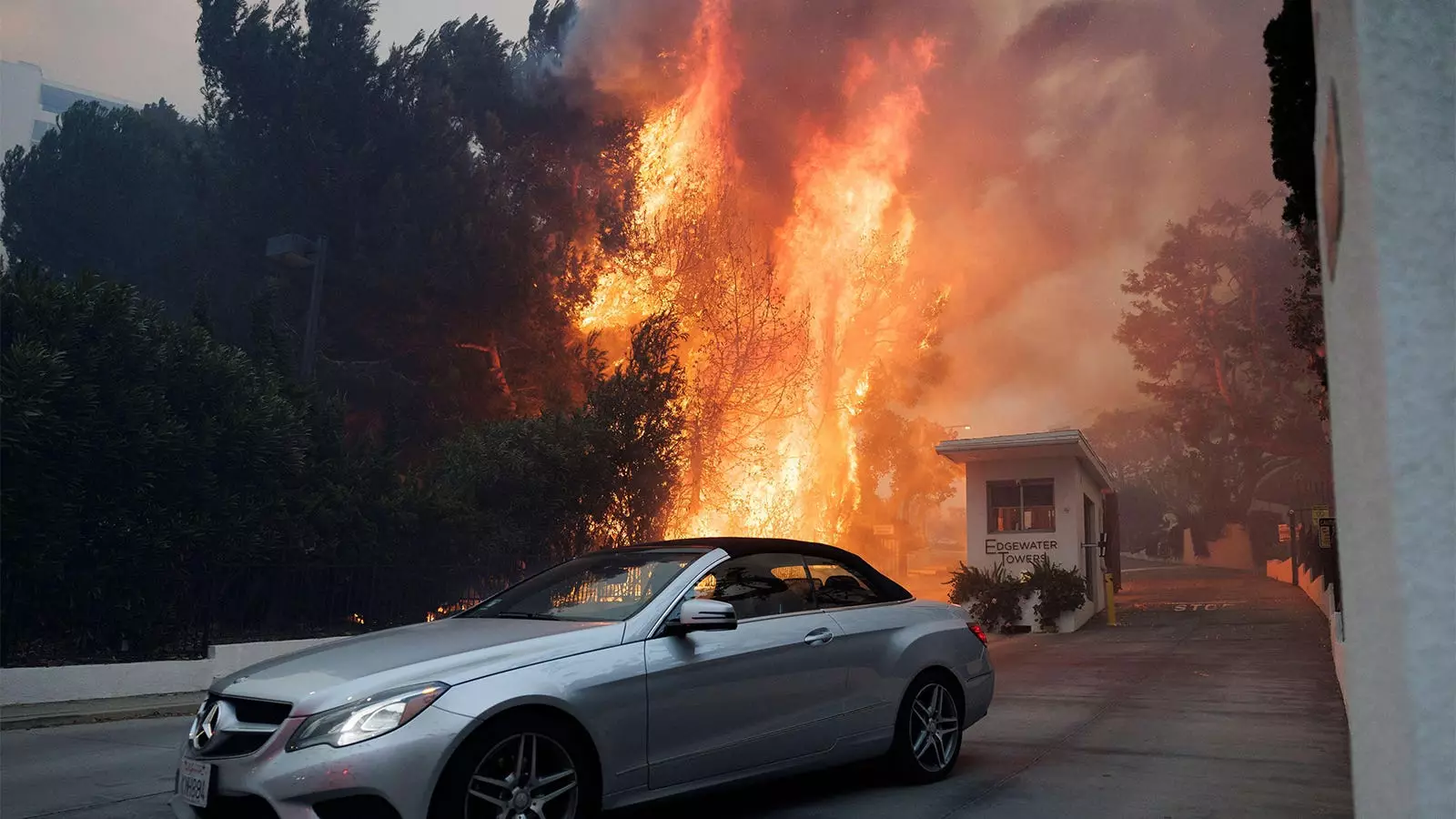Driving through the heart of Los Angeles, one is accustomed to the ceaseless drone of activity and congestion that defines this vast metropolis. However, an unsettling shift recently disrupted this norm: the empty stretches of the 405 freeway under an ominous sky filled with smoke. This was not just another night in L.A.; it was a revelation of nature’s fury, giving way to a visual cacophony reminiscent of a surrealist painting. Billowing clouds of smoke from the Palisades fire created a haunting backdrop, forcing residents and travelers alike to confront an uncomfortable reality—an increasingly fragile environment.
As I approached the mountains that cradle the San Fernando Valley, the vivid reds and oranges illuminating the horizon looked like a warning flare—a reminder of the dangers lurking within our changing climate. The trajectory of these wildfires extends beyond the immediate crisis, reaching into the very core of our public health and safety infrastructure. Every ember carries significant health implications that we can no longer afford to overlook.
The current wildfires are not just affecting the wild landscapes of California; they are critically reshaping the urban-wildland interface where human lives and natural ecosystems collide. This catastrophic event is releasing a cocktail of toxic chemicals into the atmosphere, including harmful particulates such as PM2.5 and numerous byproducts arising from combusted materials—fire retardants, plastics, and asbestos among them. Thus, the traditional notion of fire as a natural cleansing force is being replaced by a harrowing understanding of its destructive aftermath.
The primary health concern stems from inhalation injuries. Toxic particulates and airborne chemicals pose acute risks, particularly for vulnerable populations and first responders. As people flock to hospitals for urgent care due to breathing complications, hospitals are becoming strained, echoing a familiar pattern seen in past environmental disasters. The long-term ramifications extend beyond immediate physical health, embedding themselves into the communal psyche and potentially leading to chronic ill-health issues.
Wildfires not only ravage the land but also leave indelible scars on mental health. For countless individuals who’ve faced the devastation of losing their homes or being displaced, the road to recovery is not a simple one. The psychological ramifications can manifest as anxiety, depression, and post-traumatic stress disorder. Both young and old are grappling with the profound sense of loss and fear, a facet of environmental disasters that often remains unaddressed in public discourse.
In the wake of tragedy, the emotional well-being of a community is paramount, and we must shine a light on the mental health services that will be integral to recovery efforts. As Los Angeles redefines its crisis response strategies, there must be a remarkable attention to the mental health needs of its residents as they navigate the traumas inflicted by these wildfires.
As someone who has devoted their career to occupational and environmental health, the urgency of addressing these intertwined crises is undeniable. The tools we use in the field are well-equipped to handle the comprehensive nature of such disasters. Historically, healthcare professionals have launched significant initiatives in the aftermath of calamities. Just as my colleagues implemented a long-term health monitoring program for first responders post-9/11, there’s a pressing need to establish similar protocols for individuals impacted by the current wildfires in L.A.
Enhancing emergency procedures within healthcare frameworks is not merely an option but a necessity. By constructing a cohesive strategy for managing multifactorial health impacts, we can leverage the lessons learned from past crises. This crisis demands our skill set—dynamic risk assessment, evidence-based guidelines for exposure-informed care, and an adaptable response to a fluid situation.
The increasing frequency and intensity of wildfires necessitate a comprehensive reevaluation of our environmental oversight and health strategies. We are at a critical juncture—one that calls for innovative solutions that harness technology, data, and preventive medicine. It is our responsibility to initiate the development of real-time environmental monitoring systems, aggregating diverse data into accessible formats that inform decision-making and public safety initiatives.
For this to materialize, we require a strong cadre of trained occupational and environmental medicine physicians. Unfortunately, the dwindling number of accredited residency programs reflects a lack of investment in this crucial area. We must prioritize the cultivation of competent professionals who can spearhead preventive health strategies and increase resilience against environmental crises.
As Los Angeles confronts the reality of wildfires reshaping both its physical landscape and public health framework, our path forward must be defined by collaboration, innovation, and a robust commitment to both environmental and human health. Navigating this multifaceted challenge is not solely the responsibility of healthcare professionals but calls for an engaged collective response.
The future demands that we remain vigilant and proactive, overcoming these environmental adversities through ingenuity, science, and community resilience. By pivoting toward a comprehensive approach to disaster preparedness, we can emerge from these trials not merely as survivors but as leaders in the global fight against the adverse impacts of climate change. The smoky skies may cloud our vision today, but they must also inspire a clearer determination for a more sustainable and resilient tomorrow.


Leave a Reply